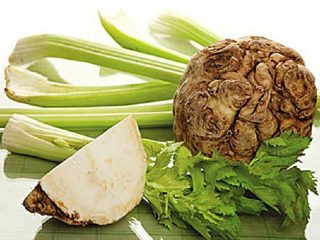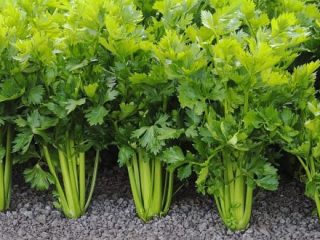Content
Root celery is a vegetable crop that, if properly grown and stored, can last until a new harvest. Its taste and aroma are not as rich as those of leaf honeycomb, and the content of vitamins, minerals and other beneficial substances is high. Root celery should be harvested on time, otherwise it will not ripen or will be damaged by frost, which will significantly reduce its keeping quality.
When to remove celery root from the garden
Celery root vegetables can be eaten when they reach a diameter of 5 cm. After full ripening, their size increases significantly, and their weight can exceed 500 g. But choosing the right time to harvest celery root for the winter is important not because of its volume. At least that matters too.
Celery has a long growing season - on average 200 days from emergence. The root crop begins to form in the second half of summer, with the main mass gain occurring from August to September.The vegetable also needs a period of ripening, when the peel acquires the necessary density and becomes able to protect the pulp from loss of moisture and infection.
There is no need to rush or delay harvesting root celery for storage. If you do this too early, the crop will not have time to gain enough nutrients, form a dense skin and will not lie well. Root celery is not afraid of short-term frosts. But exposure to low temperatures reduces its shelf life. Root vegetables will need to be eaten within a short time or processed.
Harvesting times depend on the growing region and weather. Naturally, the early varieties are dug up first, and the later ones are kept in the garden almost until frost. It is also necessary to take into account what will be done with the root crops after harvesting. Early and mid-ripening ones are eaten fresh or processed. They are intended for short-term storage, so the time of their excavation can be determined, although not arbitrarily, but very approximately. Usually they are guided by the varietal description, which indicates the approximate period that should pass from the emergence of seedlings to harvesting.
Another thing is late root celery. It can be stored until the next harvest, and harvesting dates should be determined with maximum accuracy. In addition to the fact that this needs to be done before serious frosts, gardeners focus on the following signs:
- the first snow, if it fell before a strong drop in temperature;
- yellowing and wilting of the upper part of the leaves, if this is not caused by disease, pests or dry soil;
- Root crops are dug up after harvesting late varieties of cabbage.
Roughly speaking, in the south the crop can be kept in the garden until the middle or end of November. The harvesting time for root celery in the Middle Zone is October. In the north, late varieties usually do not ripen in open ground. They are grown in greenhouses or brought from warmer regions.
When to harvest root celery in the Moscow region
Late varieties ripen well near Moscow. They need to be removed when the signs listed above appear, unless a long frost is expected earlier. Typically, late root celery in the region is harvested by late October or early November. There are no problems at all with early and mid-season varieties in the Moscow region.
When to harvest root celery in the Urals
Late varieties in the Urals often do not have time to ripen before frost. They are grown under film cover or not planted at all. In any case, the weather in the Urals is unpredictable and changeable.
If the gardener is not ready to cover the planting with heat-preserving material at any time, late varieties of root celery should be discarded and early and mid-season varieties should be grown. They are harvested, focusing on signs of ripening, starting at the end of August, throughout September, and if the weather permits, at the beginning of October.
When to harvest root celery in Siberia
Only early varieties of root celery ripen well in Siberia. Planting mid-season crops sometimes ends in failure - there is no succession year after year and frosts can begin early.
In Siberia, root crops are dug up when the signs of ripening described above appear. For early varieties this is usually the end of August - beginning of September, mid-season varieties are dug in September-October. Root vegetables that have been exposed to low temperatures or have not had time to ripen are used for preparations and eaten fresh. And in order to preserve fresh celery, at least for a short time, you should plant mid-season and early varieties.
Rules for harvesting celery root
The harvest is harvested in dry, cloudy weather. The soil should be moist, but not wet. If it rained the day before, it is better to wait - celery dug up immediately after rainfall or watering is stored worse. So you also need to guess with soil moisture - focusing on the mechanical composition of the soil, do it no later than 3 days before harvest.
They dig up celery with a pitchfork or a shovel, depending on what is convenient for you, but you need to step back from the tops at a decent distance so as not to damage the root crops. You can pull them out of the ground by the leaves only on light, loose soils, where no effort is required.
Root crops are freed from large lumps of soil. If they were dug up in cold weather, they cannot be brought into a warm room immediately; the temperature must be raised gradually. Root celery removed from wet soil is dried under a canopy or in a well-ventilated, cool room.
Then thin roots and tops are cut off, leaving columns of about 2 cm. Sorting is carried out. Root crops are rejected:
- with signs of mechanical damage;
- too small;
- affected by diseases or pests;
- deformed;
- with soft top;
- making a ringing sound when tapped (this is a sign of emptiness inside).
How to store root celery for the winter
Late varieties of root celery grown on loose soils without excessive nitrogen fertilizing are stored best and longest. Harvesting in dry weather before frost, but after the root crops have fully ripened, increases shelf life.
Root celery can be peeled, cut into pieces and dried or frozen, used for winter preparations. But it's best to keep it fresh.
Celery root is a vegetable with a long shelf life. This is a culture with a two-year development cycle; being in a state of winter dormancy, it slows down growth processes, and does not stop them altogether. The main task of the housewife during storage of root crops is to prevent their germination and the development of diseases. Under optimal conditions, late varieties will last until the next harvest.
How to store celery root at home
Root celery can be stored in the refrigerator by brushing and trimming off any small shoots. It is placed in bags or wrapped in cling film and placed in the vegetable department.
You can store root vegetables on a glazed balcony or loggia. The closer the temperature is to the optimum - from 2 to 4° C. The root celery is placed in boxes or bags and sprinkled with wet sand or peat. You should sort out the root vegetables from time to time and moisten the substrate in which they are stored. Humidity should be at 90-95%.
Damaged root vegetables can be cleaned, cut into thin petals and dried.For freezing, they are divided into cubes, and subsequently used only for preparing hot dishes.
How to store root celery for the winter in the cellar
Sorted healthy root vegetables will stay fresh for the longest time in a cellar or basement at a temperature of 2-4 ° C and a humidity of 90-95%. Just as for storage on the balcony, they are laid out petioles up in boxes or bags with peat or sand. The substrate must be kept moist at all times.
Root celery must be periodically removed from the substrate, vegetables that are beginning to spoil must be removed, and sand or peat must be moistened with water.
If there are different fruits and vegetables in the cellar that need different conditions, a different method is used. Storing root celery in winter is possible at temperatures and humidity other than optimal if the roots are placed in a mash made from clay and water. Then they are dried and stacked in rows.
After harvesting, storing root celery in a trench covered with earth outside, counting on the absence of frost, is not worth it, even in the southern regions. Real winter may still set in there, and the ground will freeze. But it’s even worse if the root vegetables sprout. It will no longer be possible to eat them.
Shelf life of celery root
Healthy root vegetables, washed and wrapped in cellophane, will remain in the vegetable compartment of the refrigerator for about a month.
At room temperature, celery root can be stored for 4 days.
Cut or peeled, wrapped in cling film in the refrigerator, it will keep for up to a week.
On a glassed-in loggia in damp sand or peat, root celery can be stored all winter.
Root vegetables stay fresh the longest in the cellar or basement. Under the right conditions they will keep for 3-6 months. You need to eat early varieties of celery quickly; late varieties can last until spring.
For more than six months, root vegetables are stored in special vegetable storage facilities with controlled temperature and humidity.
Conclusion
Root celery must be harvested on time and stored correctly. Only then will it retain its taste, nutrients and beneficial properties. If you grow the root vegetables yourself and treat them correctly from the very beginning, you can eat hot dishes and salads with fresh celery all winter.













